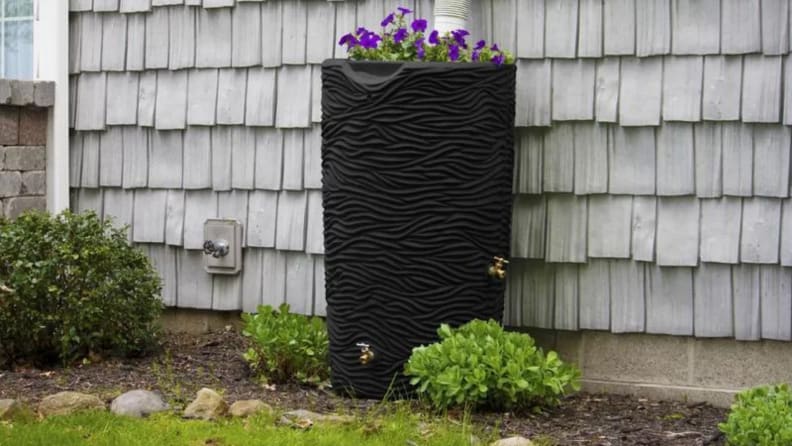A rain barrel can save you tons of money every year
Fill up your rain barrel for free and save on your water bill
Products are chosen independently by our editors. Purchases made through our links may earn us a commission.
No one waters your garden better than Mother Nature. But, when she’s not cooperating or if your water bill is drying up your household budget, you can easily play your own rain game.
According to the EPA, if the average 2,000-square foot house gets hit with one inch of rain during a storm, then it is the recipient of over 500 gallons of water, which translates to 1,300 gallons per month during the height of summer.
Instead of letting all that water go down the proverbial drain, you can save it for a not-so rainy day by using a rain barrel to harvest every raindrop—or at least the ones that hit your roof.
And, since lawn and garden irrigation can make up nearly 40% of total household water use during the summer, a rain barrel may be the answer to negating this increased cost.
What is a rain barrel?
A rain barrel is simply a large container, usually barrel-shaped, that works with your gutters and downspout to catch and store rainwater that runs off your roof. You can harvest the natural water and decrease your need to rely on your tap water for outdoor chores like watering your garden or your lawn with a sprinkler.
Abbye Churchill, a Brooklyn-based avid gardener and author of Gardens of Eden: New Residential Garden Concepts & Architecture for a Greener Planet, says, “Harvesting rainwater is a great way to help the environment while doing almost nothing. It conserves water and reduces your use of municipal water, helping to save both energy and money.”
Not to mention that it can also limit stormwater runoff and erosion.
To find out how much rain you have the chance to collect, you need to do a quick math problem: Multiply the square footage of your roof by .623 (the amount of water in gallons needed to fill one square foot of space to a depth of one inch) by the average rainfall in your area, which you can find by entering your zip code at Weather Underground.
Rain barrels range from 50- to 100-gallon capacity and can fill in just minutes in an average downpour. If you use multiple rain barrels, you can even decrease the cost of your outdoor water usage to nothing.
In a national survey by DC Urban Gardeners, a rain barrel lowered water bills by about $35 a month in the summer. For further savings, some organizations and programs offer rebates, like the River Smart Rain Barrel program in the DC area.
In drought-prone areas of the U.S. like southern California and southern Texas, it can be especially helpful to collect rainwater to reduce your use of the precious local water supply.
How to choose a rain barrel
While you can certainly find rain barrels made of all types of material (ceramic, clay, plastic, wood, metal), Churchill suggests thinking of its long-term use and your environment when settling on one.
“Plastic will last a long time, but could crack in the winter if you live in a very cold climate,” warns Churchill.
Word to the wise: In cold climates, it’s best to drain and store your barrel in the shed or garage during the winter.
“Wood could rot easily if you live in a very damp area, and unglazed ceramic-like terra cotta actually absorbs water,” she says.
In general, should you choose plastic or resin, look for recycled or recyclable versions. And don’t forget to purchase one with a mesh grate to help keep bugs at bay.
A rain barrel with a lower faucet makes it easier to access the water when you attach your garden hose.
Churchill also suggests placing the barrel near your gutter downspout, up off the ground to allow for gravity-fed water pressure. Resting it on top of concrete blocks or a rain barrel stand should do the trick, although be sure that it is level to avoid toppling once it’s full.
Keep in mind that rainwater is naturally “soft.” Translation: It doesn't have any of the chemical cleaners like chlorine and hard minerals that can be found in treated municipal water, so it helps your gardens stay extra healthy. It’s perfect for watering indoor or outdoor plants, helping with household chores like washing the car or outdoor cleaning, bathing pets, or any indoor non-potable activity.
Because the roof runoff can grab bacteria, mold, animal excrement, or roof debris and bring it into the barrel, it makes this rainwater a little less desirable than fresh from the sky—so you will want to avoid watering vegetables, fruits, and herb plants with it. Never use captured rainwater for cooking or drinking.
It's important to note that collected rainwater can grow stagnant, so use (or drain) the water and empty the barrel within a week after it rains. “Otherwise, the overflow will make the area soggy against your house,” she adds.
Decorative rain barrel options

A decorative rain barrel blends right into your backyard oasis.
While most rain barrels are just that—barrels—there are tons of other-shaped options for harvesting rainwater. You can certainly make them part of your outdoor setting.
“Aside from landscaping around the barrel or the trompe l'oeil versions that look like rocks, there are some designs that have planters or trellises attached to the tops of the barrels that integrate them into the environment,” she says.
“Consider the top of the barrel just another part of the garden.”
You can also find lovely decorative rain chains that create a lovely waterfall effect from the gutter’s end to barrel’s beginning.
Let the rain dances begin.


